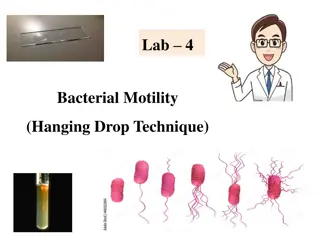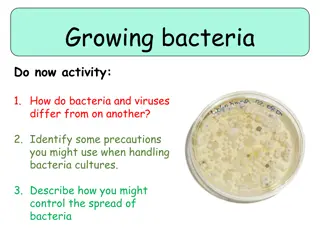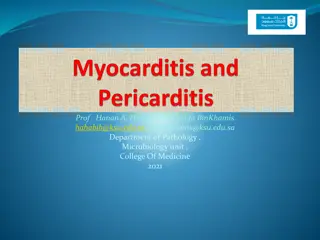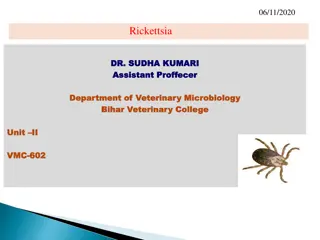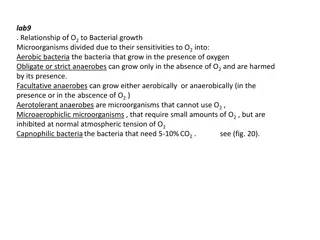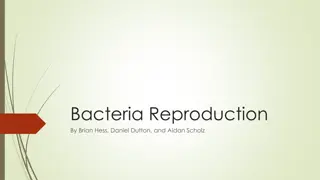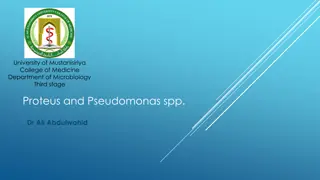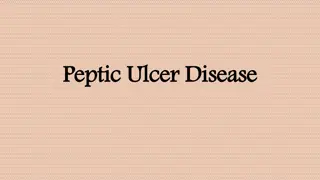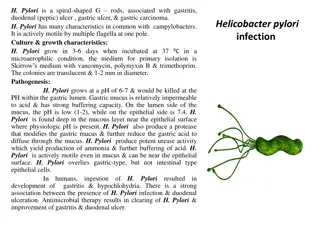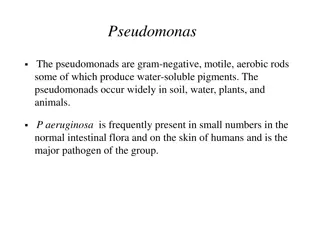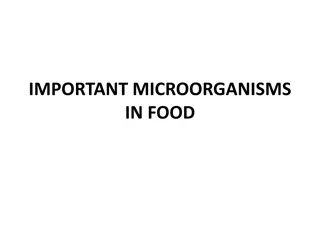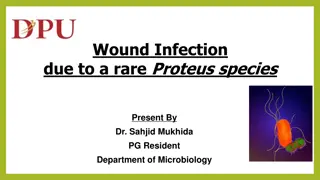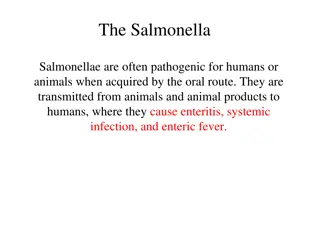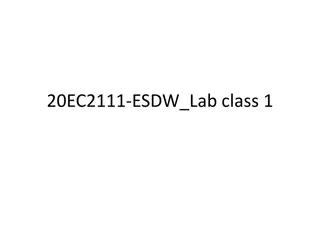Understanding Proteus Bacteria: Historical Significance, Pathogenesis, and Laboratory Diagnosis
Proteus species, named after the Greek god Proteus, exhibit pleomorphism. Their historical importance stems from the unique characteristics of H and O antigens, with flagellated strains resembling a thin film on agar. Pathogenically, Proteus mirabilis and P. vulgaris are opportunistic pathogens causing various infections. They are commonly found in nature, decomposing organic matter, and can lead to nosocomial outbreaks. In laboratory diagnosis, Proteus species show distinctive cultural characteristics such as swarming abilities and unique odors.
Download Presentation

Please find below an Image/Link to download the presentation.
The content on the website is provided AS IS for your information and personal use only. It may not be sold, licensed, or shared on other websites without obtaining consent from the author. Download presentation by click this link. If you encounter any issues during the download, it is possible that the publisher has removed the file from their server.
E N D
Presentation Transcript
PROTEUS Historical Importance Proteus species show pleomorphism Named after Greek God Proteus who was able to assume any shape
Naming of H and O antigens O antigens- Somatic, H Antigens Flagellar H antigen - Ability of flagellated strains of Proteus to grow on agar as a thin film resembling the film of breath on glass (German, Hauch = film of breath ) O antigen - thin film is not observed when strains carrying only the somatic antigen (nonflagellated strains) grow on media (German, Ohne Hauch = without film of breath )
Pathogenesis Proteus mirabilis & P. Vulgaris commonly encountered species Saprophytes: widely distributed in nature - decomposing animal matter, sewage & soil Commensals: moist areas of the skin, intestine of humans and animals Infections produced: opportunistic pathogens - urinary, wound and soft tissue infections and septicemia Nosocomial outbreaks
Pathogenesis Struvite stones in bladder: produce urease breaks down urea to form ammonia that damages the renal epithelium and makes the urine alkaline deposition of phosphate renal calculi Proteus as the basis of Weil Felix Reaction - Somatic antigen non-motile Proteus strains OX2, OX19 (from P.vulgaris) and OXK (from P.mirabilis) cross react with antigen of some Rickettsia species - Proteus antigens are used to detect heterophile antibodies in sera of patients suffering from rickettsial infections
Laboratory Diagnosis Specimen According to type of infection Direct Microscopy: Gram positive pleomorphic bacilli Pleomorphism: Proteus species are gram-negative coccobacilli occasionally appear bacillary and infila mentous forms Odour: They produce characteristic putrid fishy or seminal odour in cultures
Cultural Characteristics Swarming: ability to spread on the surface of solid media Swarming patterns: Continuous & Discontinuous swarming Common problems in the laboratory: Proteus tends to swarm and overgrow other bacterial colonies in samples with multiple types ofbacteria.
Cultural Characteristics Mechanism of swarming: At colony margin sparsely flagellated, short vegetative cells multinucleated, densely flagellated, elongated cells (20 80 m) - swarm cells - Swam cells - migrate to surrounding uninoculated - Transition from vegetative cells to swam cells takes place when the cells receive a number of extracellular and intracellular signals
Methods to prevent swarming: - Increased agar concentration to 6% - Incorporation of alcohol, boric acid, chloral hydrate, sodium azide, sulfonamide, surface active agents - Does not occur on MacConkey agar, CLED agar Organisms exhibiting swarming: P. mirabilis & P. vulgaris (not other members of tribe Proteeae) Serratia marcescens, Vibrio parahaemolyticus & Clostridium tetani
Biochemical properties Both P. mirabilis and P. vulgaris are: Species differentiation - Urease positive Test P.vulgari s Positive P.Mirabili s Negative - Citrate variable - TSI - alkaline/acid, gas present and H2S present Indole Test - MR positive but VP negative Ornithne decarboxylation Negative Positive
Typing of Proteus can be done by: - Bacteriocin typing - Bacteriophage typing - Ribotyping - Dienes phenomenon: If swarming of two Proteus isolates inoculated next to each other - Merge completely identical strains - Remain separated both strains are different
References Textbook of Medical Microbiology by Ananthnarayan, Paniker Textbook of Medical Microbiology by C.P Baweja Textbook of Medical Microbiology by S. Bhat, A.S.Sastry Textbook of Medical Microbiology by D.R.Arora, Brij bala Arora



